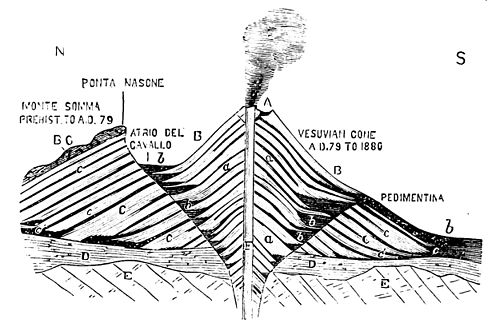pilli, and occasionally small streams of lava emitted. Before entering further into our subject, we must return a step or two. It has been mentioned that the inclination of the outer slope of the cone is that of the "angle of repose" of the rock-fragments. We should, therefore,

conclude that the inner or chimney side would be much the same. This, however, is not generally the case, the inner retaining a greater slope than the outer. It is due chiefly to the fusion, or cementing together, of the fragments by the intense heat and the presence of lava, which, so to speak, solders each mass to its neighbor. Each is retained in position by the fluid column occupying the internal cavity, and when this has disappeared the temperature is necessarily lowered, and thus there is formed a lining to the tube by the semifusion of its superficial components. Nevertheless, the upper edges crumble away, falling into the vents, thence to be again ejected. This process continually repeated will result in the majority of the lapilli falling on the outer slope, leaving the chimney of the form of a true funnel, that is to say, a cavity whose sides descend for a certain distance at a moderate angle, say roughly 45°, and then suddenly increasing to nearly a perpendicular. The consequence of this is, a basin-like cavity of sloping walls, with the volcanic vent situated at its center. The materials now ejected by the volcano, supposing it to be in a comparatively quiescent state, will tend to build up a fresh cone occupying this basin. It is not a thing unknown for such a concentric arrangement of cones and craters to be extended to many repetitions. Let us take for example the crater of Somma (Fig. 1) occupied by the cone of Vesuvius, and this again inclosing within its own walls the little cone of eruption, A. We may perhaps represent it thus: A: B:: B: C.

